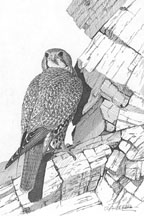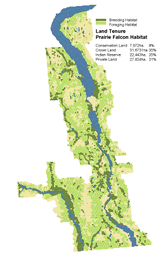|
Habitat Atlas for Wildlife at Risk
Prairie Falcon
Falco mexicanus

Prairie
Falcon
|

- Body length: 40-50 cm; wingspan: 1 metre.
- Known as a falcon by its pointed wings, narrow
tail and quick wingbeats.
- Adults are sandy-backed, with light barred chests.
- Distinguished from the rarer, Peregrine Falcon
by paler colouration on face and back.
Status:
British Columbia Red List
Special Significance
Prairie Falcon populations have declined markedly over
the past several decades. Currently, only a few pairs
of this rare resident bird breed in the Okanagan
Valley. This species is at risk because of its small
provincial population size, vulnerability to disturbance
and loss of habitat. Intensive agricultural use of
organochlorine pesticides (DDT) in the 1950-60s contributed
to the decline of birds of prey all over North America
and may have affected Prairie Falcons in the Okanagan.
The continued survival of this endangered raptor
requires protection of nesting sites and conservation
of remaining low elevation, shrub-grasslands near
cliffs and water. Further studies are required to
determine the Prairie Falcon's distribution and population
status, nesting sites and breeding behaviour.
Distribution
- In British Columbia, found in the Okanagan, Nicola, South Thompson
valleys, north to the Chilcotin-Cariboo Basin region;
breeds in the Thompson Okanagan Plateau from Okanagan and Nicola
valleys to the
Chilcotin-Cariboo Basin.
- Nests at elevations from 450 to 900 metres.
Habitat
- Prairie Falcons nest in rugged terrain on rocky cliffs near open,
sagebrush steppes.
- Their nest site is typically on a cliff ledge, in a
recessed site protected by overhanging rock; birds
sometimes nest on dirt bank or use abandoned nest of raven or hawk
on ledge.
- Nest sites are usually near water.
Reproduction
- Breeding season is from April to August.
- Adult birds court for several weeks at the nest site,
starting in April.
- Three to four eggs are laid in April; eggs are incubated
for 29 to 33 days, fledging at around 40 days.
- Nesting can be seen at nests in May to early July.
Food Habits
- Diet consists of medium-sized birds and mammals, especially ground
squirrels.
- Prey is often taken directly from the ground.
Interesting Facts
- Grassland ground squirrels go underground and hibernate in the heat
of the summer. After the young Prairie Falcons fledge, falcons often
move to alpine meadows for the rest of the summer, exploiting ground
squirrels in a new habitat.
Threats
- Extensive land development in the Okanagan Valley
has eliminated or fragmented falcon foraging
habitat (low elevation grasslands).
- Human disturbance at nest sites can cause nesting
failure.
- Persecution of ground squirrels has reduced the
Prairie Falcon's main prey.
- DDT residues may still affect Prairie Falcons and
their prey species.
Management Considerations
- Protect nest sites from human disturbance. Establish
a buffer zone of at least one kilometre radius
around nesting sites.
- Protect grasslands near suitable nesting cliffs.
|
References
1. Cannings, R.A., R.J. Cannings and S.G. Cannings. 1987. Birds of
the Okanagan Valley, British Columbia. Royal British Columbia Museum,
Victoria, BC.
2. Campbell, R.W., N. K. Dawe, I. McTaggart-Cowan,
J. Cooper, G. Kaiser and M.C. McNall. 1990. Birds of British Columbia:
Volume 2. Royal British Columbia Museum,Victoria, BC.
3. Kaufman, K. 1996. Lives of North American birds.
Houghton Mifflin Company, Boston, New York.
|